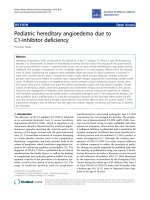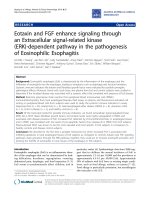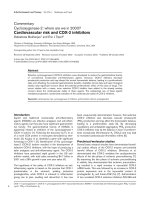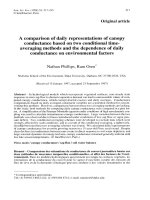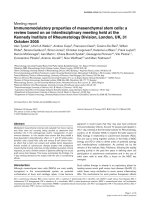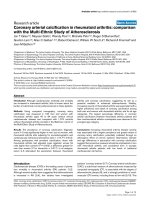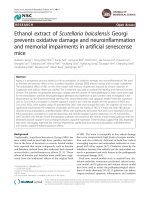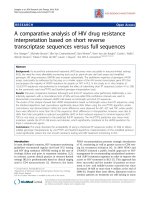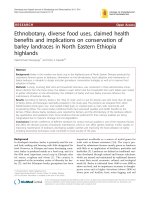Báo cáo y học: "Commentary Arterial hypertension due to fructose ingestion: model based on intermittent osmotic fluid trapping in the small bowel" ppt
Bạn đang xem bản rút gọn của tài liệu. Xem và tải ngay bản đầy đủ của tài liệu tại đây (537.47 KB, 7 trang )
© 2010 Kurbel; licensee BioMed Central Ltd. This is an Open Access article distributed under the terms of the Creative Commons Attri-
bution License ( which permits unrestricted use, distribution, and reproduction in any me-
dium, provided the original work is properly cited.
Kurbel Theoretical Biology and Medical Modelling 2010, 7:27
/>Open Access
COMMENTARY
Commentary
Arterial hypertension due to fructose ingestion:
model based on intermittent osmotic fluid
trapping in the small bowel
Sven Kurbel
Abstract
Based on recently reported data that fructose ingestion is linked to arterial hypertension, a
model of regulatory loops involving the colon role in maintenance of fluid and sodium
homeostasis is proposed.
In normal digestion of hyperosmolar fluids, also in cases of postprandial hypotension and
in patients having the "dumping" syndrome after gastric surgery, any hyperosmolar
intestinal content is diluted by water taken from circulation and being trapped in the
bowel until reabsorption. High fructose corn sirup (HFCS) soft drinks are among common
hyperosmolar drinks. Fructose is slowly absorbed through passive carrier-mediated
facilitated diffusion, along the entire small bowel, thus preventing absorption of the
trapped water for several hours.
Here presented interpretation is that ingestion of hyperosmolar HFCS drinks due to a
transient fluid shift into the small bowel increases renin secretion and sympathetic activity,
leading to rise in ADH and aldosterone secretions. Their actions spare water and sodium in
the large bowel and kidneys. Alteration of colon absorption due to hormone exposure
depends on cell renewal and takes days to develop, so the momentary capacity of sodium
absorption in the colon depends on the average aldosterone and ADH exposure during
few previous days. This inertia in modulation of the colon function can make an individual
that often takes HFCS drinks prone to sodium retention, until a new balance is reached
with an expanded ECF pool and arterial hypertension. In individuals with impaired fructose
absorption, even a higher risk of arterial hypertension can be expected.
Introduction
Despite wide range of daily salt and water ingestion, sodium and fluid homeostasis is main-
tained through orchestrated action of aldosterone, ADH, ANP and other humoral media-
tors. Actions of angiotensin II and aldosterone include vasoconstriction; increased
glomerular filtration with sodium reabsorption and potassium secretion in the distal tubule;
increased thirst and ADH secretion [1]. Beside that, a proabsorptive trophic effect of aldos-
terone on the pericryptal sheath in colonic mucosa was reported [1-3] and aldosterone
exposure leads to increased pericryptal sodium concentrations in the colon. ADH may be
another potential mediator of colonic absorption [4]. Data that link angiotensin, aldoster-
one and ADH to the sodium absorption in the colon are probably related to the increased
large bowel wall thickness found in chronic heart failure patients [5]. Taken together, it
seems that the role of colon in sodium and fluid homeostasis is often underestimated.
* Correspondence:
1
Osijek Medical Faculty Dept. of
Physiology J Huttlera 4, 31000
Osijek Croatia
Full list of author information is
available at the end of the article
Kurbel Theoretical Biology and Medical Modelling 2010, 7:27
/>Page 2 of 7
The whole picture has recently become more complex when fructose ingestion was
reported as an independent dietary risk factor of arterial hypertension [6]. It has been
known in animal models that different carbohydrate-rich diets lead to arterial hyperten-
sion [7,8], but these data were not considered applicable to healthy individuals, or to our
patients. Jalal DI et al. described association between fructose intake and blood pressure
levels in 4528 adults from the National Health and Nutrition Examination Survey. The
cross-sectional association between the fructose intake as added sugar and blood pres-
sure was examined in 4528 adults 18 years of age or older with no history of hyperten-
sion. Estimation of the fructose intake included fruit juices, soft drinks, bakery products
and candy. Multivariate logistic regression analysis showed that high fructose intake is
independently associated with higher blood pressure levels (median fructose intake was
74 grams/day, or 2.5 sugary soft drinks a day). This intake was associated with an
increased odds of blood pressure 140/90 mmHg of 1.33 (95% confidence intervals 1.09 to
1.62, p = 0.005). Beside that, even after adjusting for demographics, comorbidities, phys-
ical activity, total kilocalorie, salt and vitamin C intakes, the same fructose intake leads to
a 28%, 36% and 87% higher risk for arterial blood pressures above 135/85, 140/90, and
160/100 mmHg respectively [6]. These results clearly suggest that despite obesity and
dietary salt, the high fructose intake in the Western diet might become an independent
risk factor of developing arterial hypertension in previously normotensive adults.
In other words, although obesity per se is closely linked to hypertension, data reported
by Jalal et al. do not suggest that obesity play an intermediary role in the reported hyper-
tension - HFCS consumption link.
This theoretic paper is an attempt to interpret the reported link of fructose ingestion
and arterial hypertension by proposing a model of increased sodium absorption in the
large bowel, due to stimulation of aldosterone secretion by osmotic loads in the upper
digestive tract.
Osmotic loads of common fluids in our diet
Many isotonic "sport" drinks contain low amounts of carbohydrate (near 6%) and elec-
trolytes [9]. Various combinations of monosaccharides and sucrose are often used to
obtain isotonicity. If we look at other frequently ingested fluids, their osmolarity range is
very wide. Reported data on commercial soups [9] show that the calculated osmolarity
from their salt content (8.9 - 12.7 g/L) ranges from 300 to 435 mosm/L.
High fructose corn syrup (HFCS) is produced by splitting starch into glucose mole-
cules that are partially enzymatically converted to fructose. Typical HFCS for soft drinks
contains 55% fructose and 45% glucose. In comparison to pure sucrose solutions, the
HFCS soft drinks contain twice as many osmotically active molecules for the same
amount of sugar. Reported sugar content data of non diet soft drinks [9-11] range from
100 to 125 g/L. If only sucrose (molar mass 342.3 g/mol) is used in these beverages, the
expected calculated median of sugar generated osmolarity would be from 292 to 365
mosm/L, resulting in mildly hypertonic sucrose solution. If the same amount of sugar
(100 to 125 g/L) is added as pure monosaccharides (i.e., by adding HFCS, molar mass
180.16 g/mol), the calculated osmolarity would be doubled, from 555 to 694 mosm/L, in
concordance with reported data on the soft drink osmolarity [9,11].
Wines and beers have even higher osmotic values [9], mainly due to their ethanol con-
tent. Even weak ethanol solution of only 4%vol has 950 mosm/L [12]. Overall osmolarity
Kurbel Theoretical Biology and Medical Modelling 2010, 7:27
/>Page 3 of 7
of regular beers (ethanol and other solutes, mainly carbohydrates) ranges from 1050 to
1750 mosm/L, while wines and other alcohol beverages reach even higher values [9,12].
Intestinal fluid traffic following ingestion of hyperosmolar liquid
Similar to kitchen salt, oligosaccharides (sucrose, lactose, maltotriose etc.) and particu-
larly monosaccharides (glucose, fructose, galactose) are all osmotically active molecules.
From the beginning of duodenum throughout the rest of the small intestine, normal
digestion sustains the osmotic pressure of the intestinal contents equal to the plasma [1],
with no sudden changes in the content osmolarity. Correction of osmolarity starts in the
stomach through mixing with the gastric juice, but a combination of fluid secretion and
absorption of water and solutes in the small bowel maintains isotonicity of the intestinal
content. As food is being slowly digested in the small bowel, new osmotically active mol-
ecules are continuously liberated from food particles, but also some of them are
absorbed, so additional dilution volume by osmosis often remains limited.
The presence of hypertonic concentration of salt and/or small sugar molecules in the
gut requires some intestinal fluid to dilute the gut content to isotonicity. Intact starch is
not osmotically important since it is a huge molecule, but during enzymatic digestion of
starch, many small molecules form and act as osmotic particles. Water follows absorp-
tion of osmotically active molecules and this process maintains isotonicity of intestinal
content along the small bowel.
Due to cotransport with sodium across the mucosal membrane, many sugars and
amino acids depend on the Na
+
movement for their absorption from the gut. This net
solute transport is important when considering the quantity of water that can be moved
into the blood stream. Both glucose and galactose are in the small intestine absorbed
with sodium by active cotransporters SGLT 1, so any water from drinks containing these
sugars can be absorbed into the body circulation in less than two hours [1]. Fructose dif-
fers from glucose and galactose in the mechanism and speed of absorption. It is absorbed
through passive carrier-mediated facilitated diffusion (GLUT 5) [13-15]. In normal
adults, fructose is absorbed along the entire small bowel, so the absorption can take up
to four hours. The consequence is that any water in fructose solution remains trapped
until fructose is slowly absorbed.
The consequence of these differences in transport is that rapid rehydration requires
solutions that contain glucose and sodium, while slower water absorption can be
expected after ingestion of drinks that contain sucrose. One half water will rapidly follow
the glucose absorption, but the rest is following the slow fructose absorption.
Three clinical topics are related to the dilution of intestinal content due to osmotic
forces. The first is postprandial hypotension that is, at least partially, caused by osmotic
water traffic into the intestinal lumen [4].
Second in diarrheal patients, hypertonic drinks with a high sugar concentration can
worsen diarrhea, as they draw water out of the body and into the intestine and, thus
should never be used for peroral rehydration [2], and the World Health Organization
(WHO) recommended a hypotonic oral rehydration solution of salt and glucose. Hypo-
tonic solutions made of salt and glucose polymers from rice might be even better, proba-
bly due to slowed release of glucose molecules through enzymatic digestion of polymers.
The last example is often in patients following gastric surgery, where a sudden hyper-
osmotic load in the small bowel can cause the "dumping syndrome", due to uncontrolled,
Kurbel Theoretical Biology and Medical Modelling 2010, 7:27
/>Page 4 of 7
rapid entry of hypertonic gastric content into the small intestine, under which so much
water moves into the gut that significant circulatory hypovolemia and arterial hypoten-
sion result [7].
Osmotic load in the small bowel as a trigger leading to increased colonic
sodium absorption
Here proposed model is based on the idea that ingestion of hypertonic fluid transiently
affects the body fluid balance due to fluid shifts needed for the intestinal content dilu-
tion. This reduction of fluid volume in circulation stimulates aldosterone secretion and
increases sodium absorption in colon and reabsorption in kidneys.
Common fluids in our diet are listed in Table 1 with calculated dilution volumes
required to achieve isotonicity. The expected volume shifts after ingestion of these fluids
are shown in Fig. 1. It can be presumed that the expected total intestinal fluid volume
after ingestion of a hypertonic drink is slightly less than the sum of the ingested volume
and the intestinal fluid needed for dilution. If so, any hypertonic drink will initially take
some water out of body into the small bowel.
Due to the highest initial osmolarity, the HFCS soft drink is an important osmotic
challenge (Table 1 and fig. 1). Ingestion of 0.5 L of hypertonic HFCS drink with 800
mosm/L is expected to trap the total volume of more than 1 L of isotonic content in the
small bowel (0.5L is ingested and the rest is dilution by the intestinal fluid). Some 45% of
this enlarged fluid volume is expected to be absorbed within two hours (with glucose
absorption). The rest of it would remain in the small bowel up to four hours, due to slow
fructose absorption.
Water retained in the small bowel until sugar reabsorption is temporary sequestrated
from the body fluid compartments. Larger trapped fluid volumes (as expected after
ingestion of HFCS soft drinks) can lead to increased renin secretion and sympathetic
activity, as seen in postprandial hypotension [16,17]. Renin secretion and enhanced sym-
pathetic activity raise ADH and aldosterone secretions. These hormones retain water
and sodium in kidneys and augment sodium and water absorption in the large bowel.
Effects on kidneys are quick and transient, while alterations of the colonic sodium
absorption depend on cell renewal [3] and take hours and days to develop or dissolve [2].
It can be expected that the current capacity of sodium absorption in the large bowel
reflects the average aldosterone and ADH exposure during few previous days. An indi-
vidual that on average takes several HFCS soft drinks each day can make his colon prone
to sustained increased sodium absorption, despite adequate sodium ingestion and more
than adequate water ingestion. This can lead to a new balance that leads to an expanded
ECF compartment and increased risk of arterial hypertension. The risk can be higher in
individuals with impaired fructose absorption that might further prolong water reab-
sorption in the small bowel [18].
Ingestion of other hypertonic liquids from Table 1 seems less important. After a salty
liquid meal, some water moves into the small bowel and an increase in ADH secretion is
expected, but the aldosterone response is expected to be blunted by the large sodium
absorption. Mild changes in ADH exposure save some water in kidneys, but their influ-
ence on sodium absorption in the large bowel is probably weak.
A similar situation is expected with a sucrose containing soft drink. Initially, dilution
does not take much water, due to mild hypertonicity of sucrose drink. Eventually,
sucrose is enzymatically split in glucose and fructose and new osmotic particles take
Kurbel Theoretical Biology and Medical Modelling 2010, 7:27
/>Page 5 of 7
Table 1: The proposed interplay between osmotic loads in the upper digestive tube and sodium and fluid sparing actions imposed on kidneys and large bowel by
increased ADH and aldosterone secretion due to a transitory decline in the circulatory volume
Beverage Content & overall
osmolarity
Fluid cycle Secretion
(V = 0.5L) (O) Theoretic values Fluid absorption in hours Aldosterone ADH
Initial trapped volume
V
d
= V*O/300-V
Total volume for
absorption V
a
= V
d
+V
< 2 h with < = 4 h
Salty commercial
soup
1.3% NaCl, 400 mosm/L ~ 0.16 L ~ 0.66 L ~ 0.66 L none blocked by
sodium
absorption
increased by reduction in circulatory
volume
Sucrose soft drink 13.3% sucrose, 400
mosm/L
~ 0.16 L ~ 0.66 L ~ 0.33 L with
glucose
~ 0.33 L with
fructose
weak and transitory increase in secretion due to small
initially trapped volume
HFCS soft drink glucose 360, fructose
440, overall 800 mosm/
L
~ 0.83 L ~ 1.33 L ~ 0.6 L with
glucose
~ 0.73 L with
fructose
increased secretion due to slow fructose absorption
results in sodium & volume sparing in kidneys and large
bowel
WHO peroral
rehydrattation
solution
glucose 75, salt 170,
overall 245 mosm/L
none 0.5 L near 0.5L almost none rehydration without fluid trapping, hormone secretion is
reduced
Soft drinks with high fructose corn sirup (HFCS) are so hyperosmolar that they trap large volumes of intestinal fluid until their sugars are absorbed (Fig. 1.). Absorption takes longer for fructose [13-
15]. Other liquids are moderately hypertonic and their influences on fluid and sodium homeostasis are much weaker. The WHO recomended solution for rehydratiopn is hypotonic so no fluid is
being trapped in the small bowell.
Kurbel Theoretical Biology and Medical Modelling 2010, 7:27
/>Page 6 of 7
some additional water, but the amount is reduced by simultaneous reabsorption of these
two sugars, particularly of glucose. So, only a limited and transient increase in ADH and
aldosterone secretion can be expected.
Although highly hyperosmolar [9,12], ethanol containing beverages are deliberately
avoided in Table 1. Due to rapid ethanol absorption in the upper digestive tube [19], eth-
anol dependent osmolarity is quickly reduced, so the initial osmotic load does not last
long. Since ethanol blocks ADH secretion, only a transient aldosterone rise can be
expected after taking ethanol containing drinks.
Consequences of the proposed model
Here presented interpretations suggest that it might be important how an individual
takes carbohydrates or salt. It seems that the best way to avoid the reported risk of
hypertension from HFCS drinks is to dilute them with fresh water before ingestion, or to
drink adequate volume of fresh water immediately after the HFCS drink. Any isotonic,
or hypotonic combination of food and drinks that slowly releases both salt and sugars
might help avoid risk of arterial hypertension, due to small volume of initially trapped
fluid.
As of May 2010, PubMed lists some 150 papers considering HFCS in various settings.
Some of them are discussing relations between HFCS ingestion and blood levels of met-
abolic hormones (insulin, leptin, GHrelin etc.), aiming to link HFCS to obesity and to the
metabolic syndrome [20-22]. Since the link between HFCS and risk of hypertension is
recently published [6], it is not suprising that data on HFCS ingestion and hypertension
related endocrine or paracrine mediators are lacking in PubMed journals.
Here proposed model predicts subtle and transient changes in the circulatory volume
after the ingestion of hypertonic HFCS drink. So, only a slight increase in aldosterone
Figure 1 The proposed impact of osmotic loads in the upper digestive tract on the intestinal fluid traf-
fic (based on data from Table 1). Soft drinks with high fructose corn sirup (HFCS) are so hyperosmolar that
they trap large volumes of intestinal fluid until their sugars are absorbed. It takes much longer for fructose [13-
15]. Other liquids are moderately hypertonic and their influences on fluid traffic are much weaker.
Kurbel Theoretical Biology and Medical Modelling 2010, 7:27
/>Page 7 of 7
blood levels can be expected between one and four hours after ingestion. In other words,
the risk of future hypertension would be higher in individuals that take HFCS drinks in
regular intervals, along meals, in concordance with Jalal et al. [6]. A plausible extrapola-
tion of the same model is that both regular lactulose ingestion and impaired fructose
ingestion can also be linked to increased aldosterone exposure and risk of developing
hypertension.
Competing interests
The author declares that they have no competing interests.
Acknowledgements
This theoretic paper was financed through grants 219-2192382-2426 and 219-2192382-2386 from the Croatian Ministry
of Science, Education and Sport.
Author Details
Osijek Medical Faculty Dept. of Physiology J Huttlera 4, 31000 Osijek Croatia
References
1. Barrett KE, Barman SM, Boitano S, Brooks HL: Ganong's Review of Medical Physiology. 23rd edition. Lange Basic
Science, McGraw-Hill Medical; 2009:354-357. 359, 666-8, 440-2
2. Thiagarajah JR, Griffiths NM, Pedley KC, Naftalin RJ: Evidence for modulation of pericryptal sheath myofibroblasts
in rat descending colon by transforming growth factor beta and angiotensin II. BMC Gastroenterol 2002, 2:4.
3. Cristia E, Moretó M, Naftalin RJ: Key role of aldosterone and pericryptal myofibroblast growth in colonic
permeability. J Pediatr Gastroenterol Nutr 2007, 45(Suppl 2):S127-30.
4. Cristia E, Amat C, Naftalin RJ, Moretó M: Role of vasopressin in rat distal colon function. J Physiol 2007, 578(Pt
2):413-24.
5. Sandek A, Bauditz J, Swidsinski A, Buhner S, Weber-Eibel J, von Haehling S, Schroedl W, Karhausen T, Doehner W,
Rauchhaus M, Poole-Wilson P, Volk HD, Lochs H, Anker SD: Altered intestinal function in patients with chronic
heart failure. J Am Coll Cardiol 2007, 50:1561-9.
6. Jalal DI, Smits G, Johnson R, Chonchol M: TH-FC037: Increased fructose intake is independently associated with
elevated blood pressure. Findings from the national health and nutrition examination survey (2003-2006). J Am
Soc Nephrol 2009, 20:9A-10A.
7. Hwang IS, Ho H, Hoffman BB, Reaven GM: Fructose-induced insulin resistance and hypertension in rats.
Hypertension 1987, 10:512-6.
8. Martinez FJ, Rizza RA, Romero JC: High-fructose feeding elicits insulinresistance, hyperinsulinism, and
hypertension in normal mongrel dogs. Hypertension 1994, 23:456-63.
9. Mettler S, Rusch C, Colombani PC: Osmolality and pH of sport and other drinks available in Switzerland.
Schweizerische Zeitschrift für Sportmedizin und Sporttraumatologie 2006, 54:92-95.
10. Foster-Powell K, Holt SHA, Brand-Miller JC: International table of glycemic index and glycemic load values: 2002.
Am J Clin Nutr 2002, 76:5-56.
11. Chavalittamrong B, Pidatcha P, Thavisri U: Electrolytes, sugar, calories, osmolarity and pH of beverages and
coconut water. Southeast Asian J Trop Med Public Health 1982, 13:427-31.
12. Chari ST, Teyssen S, Singer MV: What controls should be used in studies of acute effects of alcohol and alcoholic
beverages on the stomach and the pancreas? Scandinavian Journal of Gastroenterology 1993, 28:289-295.
13. Riby JE, Fujisawa T, Kretchmer N: Fructose absorption. Am J Clin Nutr 1993, 58(5 Suppl):748S-753S.
14. Corpe CP, Burant CF, Hoekstra JH: Intestinal fructose absorption: clinical and molecular aspects. J Pediatr
Gastroenterol Nutr 1999, 28:364-74.
15. Skoog SM, Bharucha AE: Dietary fructose and gastrointestinal symptoms: a review. Am J Gastroenterol 2004,
99:2046-50.
16. Jansen RW, Lipsitz LA: Postprandial hypotension: epidemiology, pathophysiology, and clinical management.
Ann Intern Med 1995, 122:286-95.
17. de Mey C, Enterling D, Brendel E, Meineke I: Postprandial changes in supine and erect heart rate, systemic blood
pressure and plasma noradrenaline and renin activity in normal subjects. Eur J Clin Pharmacol 1987, 32:471-6.
18. Ladas SD, Haritos DN, Raptis SA: Honey may have a laxative effect on normal subjects because of incomplete
fructose absorption. Am J Clin Nutr 1995, 62:1212-5.
19. Beck IT, Dinda PK: Acute exposure of small intestine to ethanol. Dig Dis Sci 1981, 26:817-38.
20. Schaefer EJ, Gleason JA, Dansinger ML: Dietary fructose and glucose differentially affect lipid and glucose
homeostasis. J Nutr 2009, 139:1257S-1262S.
21. Stanhope KL, Havel PJ: Endocrine and metabolic effects of consuming beverages sweetened with fructose,
glucose, sucrose, or high-fructose corn syrup. Am J Clin Nutr 2008, 88:1733S-1737S.
22. Livesey G, Taylor R: Fructose consumption and consequences for glycation, plasma triacylglycerol, and body
weight: meta-analyses and meta-regression models of intervention studies. Am J Clin Nutr 2008, 88:1419-37.
doi: 10.1186/1742-4682-7-27
Cite this article as: Kurbel, Arterial hypertension due to fructose ingestion: model based on intermittent osmotic fluid
trapping in the small bowel Theoretical Biology and Medical Modelling 2010, 7:27
Received: 3 April 2010 Accepted: 25 June 2010
Published: 25 June 2010
This article is available from: 2010 Kurbel; licensee BioMed Central Ltd. This is an Open Access article distributed under the terms of the Creative Commons Attribution L icense ( which permits unrestricted use, distribution, and reproduction in any medium, provided the original work is properly cited.Theoretical Biology and Medical Modelling 2010, 7:27
